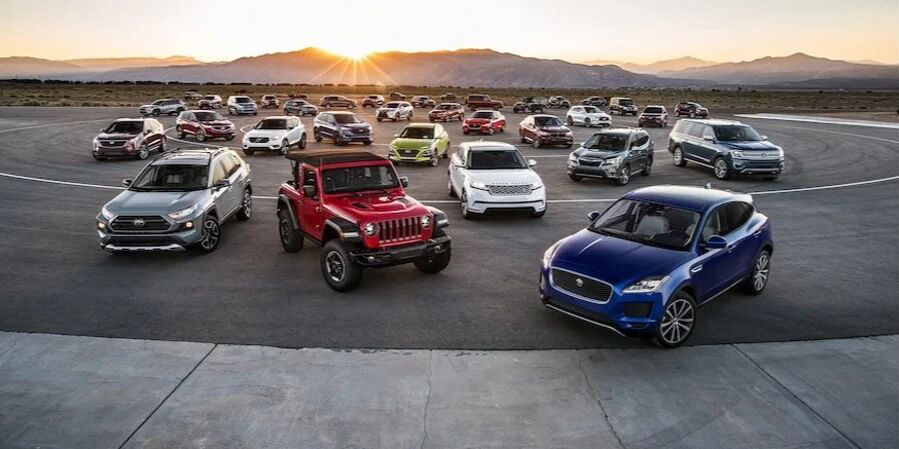In recent years, there has been a surge in the popularity of crossover SUVs with many people choosing these vehicles over traditional sedans and SUVs which have dominated the market for decades. But what exactly are crossover SUVs, and what makes them so appealing to consumers? First, we will explore the definition of crossover SUVs, examine their advantages over other vehicle types, and consider the reasons why they have become such a popular choice for car buyers in the United States.
What are Crossover SUVs?
Crossover SUVs (CUVs) are essentially a fusion of a traditional SUV and a 4-door sedan. It combines the best attributes of both body styles into a very practical package. Rather than being built on a body-on-frame platform, CUVs are engineered as a unibody in the same way sedans are. This allows crossover SUVs to be lighter and more fuel efficient while maintaining most of the utility offered by traditional SUV vehicles.
CUVs typically have a higher ground clearance than sedans which makes them better suited to tackle off road terrain or inclement weather conditions. Many drivers appreciate the added visibility that comes from sitting higher up on the road. They also generally offer more cargo space than sedans while being more compact than traditional SUVs. These features make CUVs a very practical choice for consumers who are looking for the utility of an SUV but the maneuverability and fuel efficiency of a sedan.
History of Crossover SUVs
Crossover SUVs first appeared in the late 1990s as car manufacturers began to recognize the growing demand for vehicles that combined the utility of SUVs with the comfort and fuel efficiency of sedans. The Toyota RAV4, Honda CR-V, and Subaru Forester were among the first crossover SUVs to hit the market, and they quickly gained popularity among consumers.
Over the past two decades, the popularity of crossover SUVs has continued to expand, and today they account for a significant portion of the overall SUV market. In fact, data has shown that crossovers are the most popular segment of light vehicles in the US.
Types of Crossover SUVs
Crossover SUVs are classified based on their size. They’re offered in a wide range of categories from subcompact to full-size. The main types of crossover SUVs include:
1. Subcompact Crossovers
Subcompact crossovers are the smallest type of crossover SUVs. They are typically built on the same platform as subcompact cars and generally offer the best fuel efficiency and maneuverability among CUVs. For instance, the Toyota C-HR is built on the same platform as the Toyota Corolla. Examples of subcompact crossovers include the Mazda CX-3 and Honda HR-V.
2. Compact Crossovers
Compact crossovers are slightly larger than subcompact crossovers and offer more cargo space and passenger room. They are built on the same platform as compact cars and offer a great mixture of fuel efficiency and utility. Examples of compact crossovers include the Ford Bronco Sport and Nissan Rogue.
3. Midsize Crossovers
Midsize crossovers are the next size up. This segment provides drivers with a solid balance of utility and comfort. Examples of midsize crossovers include the Toyota Highlander and Honda Pilot.
4. Full-Size Crossovers
Full-size crossovers are the largest type of crossover SUVs and offer the most space for passengers and cargo. They are built on the same platform as full-size sedans and offer a high level of comfort and luxury at the expense of MPGs. Examples of full-size crossovers include the Chevrolet Traverse and Ford Explorer.
Advantages of Crossover SUVs
Crossover SUVs offer a number of advantages over other types of vehicles, including:
1. Higher Ground Clearance
Crossover SUVs typically have a higher ground clearance than sedans, which makes them better suited for rough terrain or inclement weather. This can be especially useful for drivers who live in areas with snow or mud.
2. More Cargo Space
Crossover SUVs offer more cargo space than sedans, which makes them a good choice for families or individuals who need to transport large items. Crossovers have a 5 door design which increases trunk space and headroom compared to sedans. This can be especially useful for road trips or those with outdoor hobbies.
3. Better Fuel Efficiency
Crossover SUVs are typically more fuel-efficient than traditional SUVs which can save drivers money at the fuel pump. Crossovers are built on car platforms rather than truck platforms which make them lighter and more aerodynamic compared to their counterparts.
4. More Passenger Space
Crossover SUVs offer more passenger space than sedans which make them a popular choice for families with children. The unibody structure of CUVs allow for a more efficient use of interior space. Road trips are made comfortable for passengers thanks to ample head and leg room.
Why are Crossover SUVs So Popular?
Crossover SUVs have become increasingly popular in recent years, and there are several reasons why. Some of the main factors driving the popularity of crossover SUVs include:
1. Versatility
Crossover SUVs are versatile vehicles that can be used for a wide range of purposes, from commuting to work to going on family road trips. They are a great choice for buyers who need a do-it-all vehicle. Their combination of utility, comfort, and fuel efficiency make them a compelling choice for drivers who desire a car suitable for almost any situation and lifestyle.
2. Safety Features
Crossover SUVs typically come with a wide range of safety features, such as airbags, anti-lock brakes, and stability control. Drivers can also appreciate a more substantial road presence compared to sedans citing benefits such as increased visibility to other drivers on the road. Crumple zones are more robust than body-on-frame SUVs which can make them a safer choice in most scenarios. It’s important to note that even the safest vehicles can’t protect drivers from injuries caused by an accident due to somebody else’s negligence. To learn more about how negligence affects personal injury cases and recovering damages, click here.
3. Style and Aesthetics
Vehicle manufacturers tend to style their crossover SUVs with a rugged and polished design that appeals to a variety of consumers. They often feature sleek body lines, sporty accents, and attractive color options which can make them stand out on the road.
4. Ease of Driving
Crossover SUVs are typically easier to drive than traditional SUVs, which can be large and unwieldy in urban environments. Crossovers are more maneuverable and offer better visibility, which can make them easier to park and navigate in tight spaces.
Drawbacks of Crossover SUVs
While crossover SUVs offer many advantages, there are also some drawbacks to consider. Some of the main drawbacks include:
1. Reduced Fuel Efficiency Compared to Sedans
While crossover SUVs are more fuel-efficient than traditional SUVs, they generally earn a lower gas mileage than sedans. This can be a drawback for drivers who prioritize fuel efficiency; but for most, the difference is negligible when considering the added utility.
2. Less Off-Road Capability Compared to Traditional SUVs
Crossover SUVs are not designed for serious off-road use and may not perform as well as traditional SUVs in rugged terrain or extreme weather conditions. However, many models offer all-wheel-drive which make them fairly competent in low traction situations and suitable for a vast majority of drivers.
3. More Expensive Compared to Sedans
Crossover SUVs are typically priced higher than comparable sedans due to their larger size and increased features. Buyers who are on a tighter budget should consider a different option.
4. Limited Towing Capacity
Crossover SUVs typically have a lower towing capacity than traditional SUVs or trucks. Buyers looking to tow heavy trailers should stick with a body-on-frame vehicle if towing is a priority.
Conclusion
Over the past few years, crossover SUVs have exploded in popularity thanks to their impressive combination of utility, comfort, and fuel efficiency that can’t be matched by other vehicle segments. With their higher ground clearance, larger cargo space, and more passenger room, it’s easy to see why dealers can’t keep these on the lot. It doesn’t come without some compromise, however. While crossover SUVs offer better fuel efficiency than larger SUVs, they still can’t match the MPGs of a sedan. And while they can handle some off-road terrain, they may not have the same capability as a true off-roading, body-on-frame vehicle. They also tend to be more expensive than sedans, and are limited in terms of towing capacity.
Deciding whether a crossover SUV is right for you ultimately comes down to your own individual priorities. If you place a premium on versatility, safety, and style, a crossover SUV could be the perfect choice. On the other hand, if you’re more concerned with fuel efficiency, off-road capability, or towing power, you might want to consider a different type of vehicle. But for most, a crossover SUV strikes the perfect balance between a sedan and SUV with minimal compromise.




